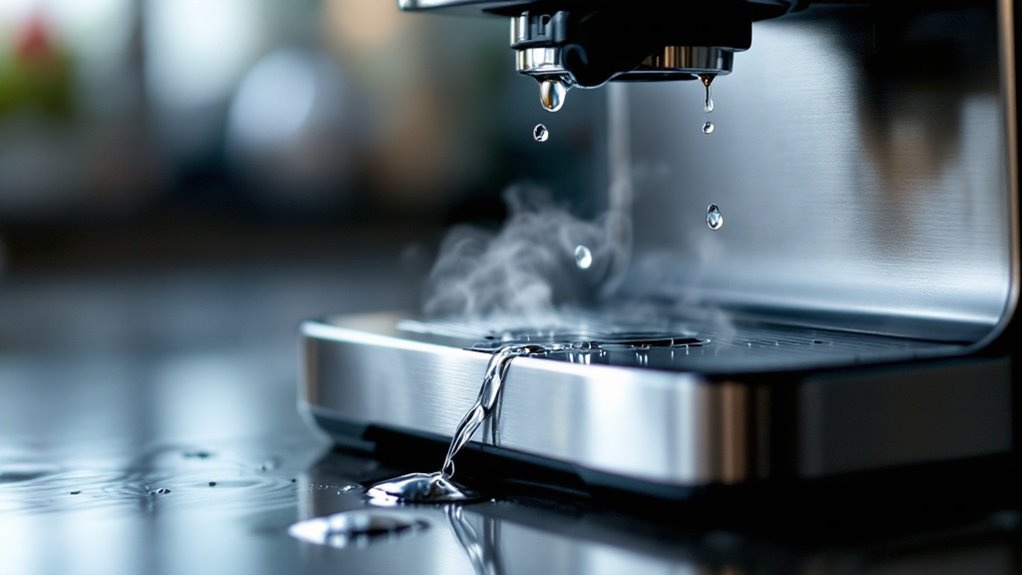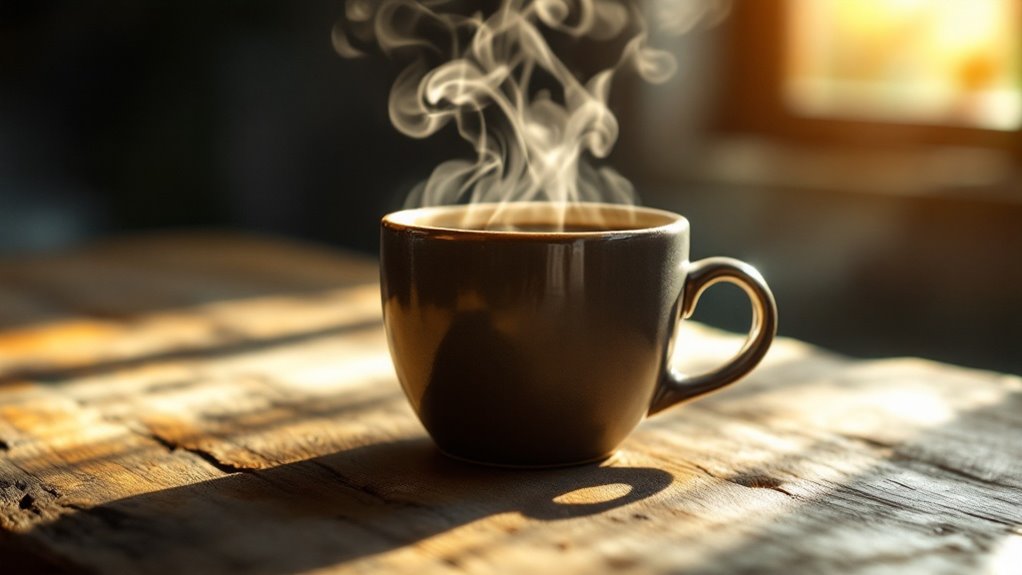



You've brewed your coffee, but instead of the rich, balanced flavor you expected, it's unpleasantly sour. This isn't just bad luck—it's likely a sign of under-extraction, where your brewing process hasn't pulled enough flavor from the beans. Factors like grind size, water temperature, or brew time could be the culprits, but there's more to it. Light roasts and certain beans naturally lean toward acidity, which can tip the scales if not handled properly. So, what's the fix? The answer lies in understanding how these elements interact—and how you can tweak them to transform your cup.
Key Takeaways
- Under-extraction from coarse grind size or short brew time leaves acidic compounds dominant, resulting in sour coffee.
- Light roasts and under-roasted beans naturally have higher acidity, amplifying sourness if not brewed correctly.
- Brewing with water below 195°F leads to under-extraction, leaving coffee sour and unbalanced.
- Dirty equipment or stale grounds can introduce unwanted sourness, affecting the overall flavor of the coffee.
- Espresso shots pulled in under 20 seconds or French press brewed for less than 4 minutes often taste sour due to under-extraction.
What Causes Sour Coffee?
Sour coffee often stems from under-extraction, where water doesn't fully dissolve the compounds in the coffee grounds, leaving behind a sharp, acidic taste. If your grind is too coarse, water flows through too quickly, failing to extract the balanced flavors from the beans. Conversely, a grind that's too fine can clog your brewing device, leading to uneven extraction and sour notes. Light roasts and single-origin beans naturally have higher acidity, which can amplify sourness if not brewed carefully. Under-roasted beans also contribute, as they retain excessive acidity, resulting in a grassy, hay-like flavor.
Water quality plays a critical role in extraction. Impurities or high mineral content can disrupt the brewing process, altering how flavors dissolve from the grounds. Always use filtered water to guarantee consistency. Dirty equipment is another culprit; residual oils or old grounds can contaminate your brew, introducing unwanted sourness. Clean your grinder, brewer, and filters regularly to avoid this.
The Role of Acidity in Coffee
Acidity in coffee often defines its character, adding brightness and complexity to the cup. It's a natural component that enhances flavor, creating a tangy or fruity sensation on your palate. The primary acids, like citric acid, contribute distinct flavor notes—think citrusy, green apple, or even floral undertones. When balanced, acidity elevates the coffee's profile, making it vibrant and lively. However, if the acidity becomes too pronounced, it can tip into a sour taste, overwhelming the other flavor notes.
The level of acidity varies by bean origin. Ethiopian coffees, for example, are renowned for their high acidity, offering bright, fruity flavors reminiscent of berries or tropical fruits. In contrast, Brazilian beans tend to have lower acidity, leaning toward nutty or chocolatey profiles. The roasting process also plays a role; lighter roasts preserve more acidity, while darker roasts mellow it out. When brewing, you'll want to extract the coffee's acidity properly to avoid harshness. A well-balanced cup showcases acidity as a highlight, not a flaw, ensuring a harmonious interplay of flavor notes that make your coffee truly exceptional.
Common Brewing Mistakes Leading to Sourness
Using a grind size that's too coarse or brewing for too short a time can leave your coffee tasting unpleasantly sour. Coarse grinds reduce surface area, limiting extraction, while insufficient brew time fails to pull out the sugars and compounds that balance acidity. Both mistakes result in under-extraction, leaving sharp, tangy flavors dominant in your cup.
Incorrect Grind Size
Grinding your coffee beans incorrectly can sabotage your brew, leading to a sour taste that's far from enjoyable. The grind size directly impacts extraction time, which is critical for balancing flavors. If your grind is too coarse, water flows through the coffee grounds too quickly, resulting in under-extraction. This leaves behind bright, acidic notes that dominate the cup, creating an unpleasant sourness. For pour-over methods, a medium grind size guarantees water interacts with the grounds long enough to extract sweetness and complexity without overdoing it. Conversely, finer grinds are essential for espresso or AeroPress, as they increase surface area and slow water flow, allowing for full extraction. However, using a coarse grind for French press without adequate steeping time can still yield sour coffee, as the water fails to dissolve enough flavor compounds. Adjusting your grind size finer can often resolve sourness by extending extraction time and enhancing flavor balance. Always match your grind size to your brewing method to avoid this common pitfall and achieve a well-rounded, satisfying cup.
Short Brew Time
Brew time plays a pivotal role in determining whether your coffee leans toward sourness or balance. A short brew time often leads to under-extraction, where water and coffee grounds don't interact long enough to dissolve the full spectrum of flavors. In methods like French press, brewing for less than 4 minutes results in sour flavors, as acids are extracted first, while sugars and balancing compounds remain trapped in the grounds. Similarly, pour-over brews under 2.5 minutes lack the depth needed to counteract acidity, leaving the cup sharp and unbalanced. Espresso shots pulled in under 20 seconds are particularly prone to sourness, as the rapid extraction primarily captures acidic compounds. Even cold brew, which typically requires 12–24 hours, can taste sour if steeped for too short a duration, as the extended contact time is essential for full extraction. With AeroPress, brewing for less than 1 minute often yields a bright but overly acidic cup. To avoid sour flavors, make sure your brewing process allows sufficient time for water to fully extract the coffee's soluble compounds, achieving a harmonious balance.
How Grind Size Affects Coffee Flavor
The grind size of your coffee beans plays a critical role in shaping the flavor profile of your brew. A coarse grind exposes less surface area, slowing extraction and often leading to under-extraction. This results in a sour, acidic taste as the water fails to dissolve enough soluble compounds. Conversely, a fine grind increases surface area, accelerating extraction. While this can reduce sourness, it risks over-extraction, producing bitter, astringent flavors if not paired with precise brew time. For methods like French press, a coarse grind works best, but insufficient steeping time (less than 4 minutes) can still leave your coffee sour. Espresso demands a very fine grind to achieve rapid extraction within 20–30 seconds, ensuring balanced flavor without sourness. Pour-over methods thrive with a medium grind, striking a balance between extraction speed and flavor clarity. Adjusting your grind size allows you to control extraction, directly influencing coffee flavor. Too coarse, and you'll taste underdeveloped acidity; too fine, and bitterness may dominate. Mastering grind size is key to revealing a well-rounded, satisfying cup.
The Impact of Brew Time on Extraction
Brew time directly influences extraction balance, determining whether your coffee skews sour or bitter. If your brew time's too short, you'll under-extract, leaving acidic compounds dominant and creating a sharp, sour taste. Stick to ideal brew times—like 3–4 minutes for French press or 20–30 seconds for espresso—to achieve a balanced, flavorful cup.
Brew Time and Extraction Balance
When your coffee tastes sour, it's often a sign that the brew time wasn't long enough to achieve a balanced extraction. Acids are extracted early in the brewing process, and if you cut the brew time short, you'll primarily taste these bright, tangy compounds without the deeper, sweeter, or bitter notes that develop later. This imbalance results in under-extraction, where the extraction yield—the percentage of solubles dissolved from the coffee grounds—falls below the ideal 18%–22% range. To counteract sour flavors, you'll need to extend the brewing time slightly, allowing more solubles to dissolve and creating a more harmonious cup. For example, in a pour-over, increasing the brew time from 2 to 3 minutes can shift the extraction yield closer to the perfect range, reducing sourness. However, be cautious not to over-extract, as excessively long brew times can introduce bitterness. Each brewing method has its sweet spot: French press typically requires 3–4 minutes, while espresso demands precision at 20–30 seconds. By fine-tuning your brew time, you'll achieve a balanced extraction that avoids both sour and bitter extremes.
Short Brew Time Risks
Short brew times can sabotage your coffee's flavor profile, leaving you with a cup that's unpleasantly sour. When you cut brew time too short, you risk under-extraction, where only the most soluble compounds—primarily acids—dissolve into your brew. This imbalance skews the extraction yield, leaving behind the sweet and bitter compounds that round out the flavor balance. For example, brewing for less than 2 minutes in methods like pour-over or French press often results in sour coffee, as the water doesn't have enough contact time to fully extract the desirable flavors. Even in espresso, where brew times are naturally shorter, pulling a shot for less than 20 seconds can emphasize sourness due to under-extraction. Adjusting your brew time by just 15-30 seconds can markedly improve extraction yield, reducing sourness and creating a more harmonious cup. Pay attention to your method's recommended brew time—whether it's 4-6 minutes for French press or 2.5-4 minutes for pour-over—to avoid the pitfalls of short brew times and achieve a balanced, flavorful extraction.
Optimal Brew Time Guidelines
Achieving the perfect cup of coffee hinges on mastering brew time, as it directly influences extraction and flavor balance. For French press, aim for 3–4 minutes to guarantee proper extraction without under-extracting, which can leave you with a sour flavor. Espresso requires precision, with a brew time of 20–30 seconds to avoid over-extraction, which introduces a bitter taste, or under-extraction, which results in sourness. Pour-over methods like V60 or Chemex typically take 2.5–4 minutes, depending on grind size and water flow rate, to achieve balanced extraction. Brewing temperature also plays a critical role; too low, and the coffee grounds and water won't interact effectively, leading to under-extraction and sourness. Conversely, too long a brew time can over-extract compounds, creating bitterness rather than correcting sourness. Always tailor your brew time to your method and grind size, making sure the coffee grounds and water interact ideally. By adhering to these guidelines, you'll avoid the pitfalls of sour flavor or bitter taste, achieving a well-balanced cup every time.
Water Temperature and Its Importance
Water temperature plays a critical role in shaping the flavor of your coffee, as it directly influences the extraction process. When brewing, aim for a water temperature between 195°F and 205°F to achieve ideal coffee extraction. If the water is too cool (below 195°F), it won't dissolve enough flavor compounds, leaving your coffee under-extracted and sour. Conversely, water above 205°F can over-extract, pulling out bitter elements instead of balancing acidity and sweetness.
For light roasts, which are denser and packed with complex, acidic flavors, use water closer to 205°F to guarantee full extraction without sourness. Dark roasts, being more porous and soluble, require slightly lower temperatures—around 195°F—to avoid over-extraction and maintain a smooth, balanced profile. Precise brewing control over water temperature guarantees you extract the right balance of acids, sugars, and oils, creating a cup that's neither sour nor bitter. Always monitor your water temperature carefully, as even a few degrees can drastically alter the sensory experience of your coffee.
Choosing the Right Coffee Beans
The beans you choose substantially influence whether your coffee leans toward sourness or balance. Light-roasted beans, such as Ethiopian or Kenyan varieties, often exhibit bright, fruity acidity that can tip into sourness if under-extracted. These single-origin coffees are prized for their complex, tangy notes, but they require precise brewing to avoid an overly sharp taste. Conversely, Brazilian beans, with their lower acidity and nutty, chocolatey profile, are less likely to taste sour, making them a safer choice if you prefer a smoother cup.
When selecting coffee beans, consider the roast level. Light roasts retain more of the bean's natural acidity, which can amplify sourness, while dark roasts develop caramelized sugars that mask acidity and deliver richer, more balanced flavors. Freshness also plays a critical role; beans roasted within the last 3-4 weeks maintain their natural sweetness, whereas stale beans lose complexity and develop unbalanced acidity. By choosing the right coffee beans—whether it's a bright Ethiopian, a fruity Kenyan, or a mellow Brazilian—you can control the acidity and avoid unwanted sourness in your brew.
Adjusting Your Brewing Method
If your coffee often tastes sour, tweaking your brewing method can make a significant difference. Start by adjusting your grind size; a finer grind increases surface area, allowing more flavor to be extracted during the brew. For methods like pour-over or AeroPress, this can reduce sourness by guaranteeing proper extraction. When using a French press, extend your brew time to at least 4 minutes to fully extract the coffee's flavors. Under-extraction, often caused by insufficient time, leaves acidic compounds dominant, resulting in a sour taste. Maintain water temperature between 195°F and 205°F, as cooler water fails to extract the full spectrum of flavors. Stir the grounds during brewing to guarantee even saturation, which prevents pockets of under-extracted coffee. Finally, adjust your coffee-to-water ratio to 1:15 or 1:16; too little water can concentrate acidic compounds, amplifying sourness. By refining these variables—grind size, time, temperature, and ratio—you'll achieve a balanced brew with a harmonious taste profile, free from unwanted sourness.
Tools and Techniques to Fix Sour Coffee
Several tools and techniques can help you fix sour coffee by addressing under-extraction and optimizing your brewing process. Start by adjusting your grind: finer grinds increase surface area, enhancing extraction and balancing sour coffee tastes with sweetness. For methods like pour-over or AeroPress, a finer grind is particularly effective. Conversely, if your coffee tastes sour due to over-extraction, switch to a coarser grind to reduce bitterness and acidity.
Ensure your water used is between 195°F and 205°F, as cooler water leads to under-extraction and sourness. Experiment with your coffee-to-water ratio; a 1:16 ratio often dilutes acidity, creating a more balanced cup. Clean your equipment regularly to prevent residue buildup, which can amplify sour flavors.
For French press, extend brew time to 3-4 minutes, and for espresso, aim for 20-30 seconds to achieve proper extraction. These adjustments, combined with precise measurements and consistent techniques, will help you eliminate sour coffee tastes and craft a well-rounded, flavorful brew.
Disclosure: As an Amazon Associate, I earn from qualifying purchases.






